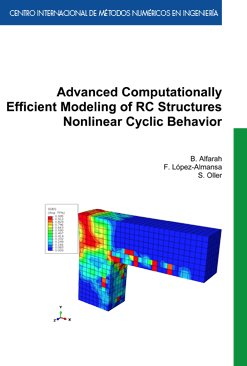Advanced Computationally Efficient Modeling of RC Structures Nolinear Cyclic Behavior
FREE!
Editorial: CIMNE
Year of publication: 2017
Pages: 198
Index: Acknowledgements; Resumen; Summary; List of Figures; List of Tables; List of symbols; General introduction to earthquake engineering.
PART I-CONTINUUM MECHANICS-BASED APPROACHES:
1. Introduction and motivation; 2. Concrete modeling; 3. Proposed methodology for calculating damage variables of CPDM; 4. Reinforcing bars modeling; 5. Bond-slip effect modeling; 6. Finite element analysis verification examples; 7. Continuum mechanics-based approaches concluding remarks.
PART II-STRUCTURAL COMPONENT-BASED APPROACHES:
1.Introduction and motivation; 2. Models for nonlinear analysis; 3. Structural component-based vs continuum mechanics-based approaches; 4. Developed model for non-ductile RC structures simulation; 5. Nonlinear dynamic analysis of non-ductile RC structures; 6. Structural component-based approaches concluding remarks.
Editorial: CIMNE
Year of publication: 2017
Pages: 198
Index: Acknowledgements; Resumen; Summary; List of Figures; List of Tables; List of symbols; General introduction to earthquake engineering.
PART I-CONTINUUM MECHANICS-BASED APPROACHES:
1. Introduction and motivation; 2. Concrete modeling; 3. Proposed methodology for calculating damage variables of CPDM; 4. Reinforcing bars modeling; 5. Bond-slip effect modeling; 6. Finite element analysis verification examples; 7. Continuum mechanics-based approaches concluding remarks.
PART II-STRUCTURAL COMPONENT-BASED APPROACHES:
1.Introduction and motivation; 2. Models for nonlinear analysis; 3. Structural component-based vs continuum mechanics-based approaches; 4. Developed model for non-ductile RC structures simulation; 5. Nonlinear dynamic analysis of non-ductile RC structures; 6. Structural component-based approaches concluding remarks.
Description
Under severe seismic excitation, structural behavior of buildings and other constructions is highly complex. It involves, among other issues, soil-structure interaction, large strains and displacements, damage, plasticity, and near-collapse behavior. Moreover, in reinforced concrete structures, there are several coupled degradation and failure modes: cracking, crushing and spalling of concrete, yielding and pull-out of tensioned reinforcement, yielding and buckling of compressed reinforcement.
Furthermore, another circumstance makes the situation more alarming: given the increasing awareness and concern on the huge worldwide seismic risk, earthquake engineering has experienced in last years substantial advances. New design and analysis strategies have been proposed, leading to relevant developments. These developments rely on extensive testing and numerical simulation mainly based on oversimplified models referred in this work as structural component-based models, as a result of their moderate computational cost. Therefore, there is a strong need of verifying the reliability of the new developments by comparison with analyses performed using more advanced simulation tools and with experiments. This work is organized in two parts. First part presents an accurate model, while the second part deals with a more simplified model, although highly computational efficient.
Additional information
| format | Monograph |
|---|---|
| Year of Publication | 2017 |

